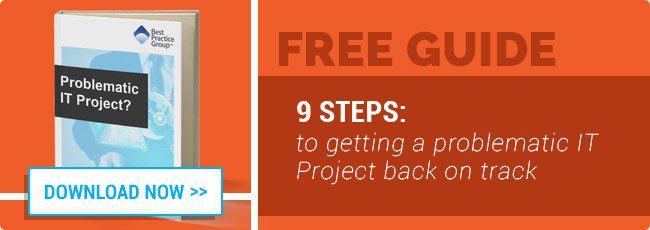
Research advisory organisation, The Standish Group, reported in their now infamous Chaos report that just 33% of all IT projects are completed on time and in budget. And though these reports started nearly 20 years ago, the updates they provide each year indicate that although things are improving marginally, more IT projects still go wrong than succeed.
The ‘Chaos’ reports are still being used as a statistical benchmark by industry commentators. Others, like CIO, the industry resource and magazine for Chief Information Officers, are a little more conservative in their estimates. Their report shows that 50% of companies they’d surveyed had experienced a failed IT project in the preceding year.
Whatever the actual number, any statistic approaching 50% indicates less than favourable news; representing evidence that a high proportion of all IT projects undertaken are either abandoned, do not achieve their stated goals, or come in late and/or over budget.
The reports sight that a lack of foresight, contingency, risk planning and restrictive contracts are potential reasons for this.
With such projects often being large and complex in nature, it is not at all surprising that these numbers reflect the challenges being experienced. In our own experience of dealing with many complex IT integration projects, we find that some clients and suppliers will look to take shortcuts, not consider practical eventualities, fail to appreciate the ramifications of actions, or simply not employ those with the right skills and specialist knowledge to recognise when things have the potential to go, or are going, wrong.
However, in the project reviews we undertake, we also see that by taking the right approach it is possible to turn even the most potentially ill-fated of IT projects around. This requires asking the right questions of the right people at the right time, and following a tried and tested method to identify and quantify client expectations appropriately, engage with the market, have a robust procurement method that encourages the vendor to provide good pre-contractual advice, project/contract management and post-contract governance structure.
Five steps to shifting the balance towards ensuring a successful outcome with your IT project
Common sense tells us all that it is almost always going to be better for a project to seek to resolve any issues that you have, rather than to allow it to degrade to a point of collapse or to look to early supplier partnership termination in order to start again with a new provider. Because of this it is vital to explore any misunderstandings with your vendor, and how these misunderstandings have been caused, with the greatest of care.
Here are five key steps for approaching that all important exploratory discussion with your supplier, in such a way that enables you to quickly minimise any potential rift from increasing. They will also help to realign the relationship to one that has a greater chance of not only survival, but one that sees you through to a successful conclusion.
1. What evidence exists so that you are clear, balanced and fair about your facts?
It is one thing to suspect that your IT supplier has caused your project to go awry. It’s another thing entirely as to whether the evidence supports that being the case. If you believe that your IT partner is doing something that is jeopardising the success of your project, the first step should be a thorough investigation into the causes of the problem and to avoid getting too wrapped up in the symptoms.
If you have maintained a close working relationship with your vendor counterparts, or given your Intelligent Client Function (ICF) team the freedom to gather relevant and regular ‘intelligence’, you may already have the evidence you seek within their reports. But, at this stage, any investigation should be carried out carefully so as to not bring the matter to the other party’s attention until you are clear about what the evidence is telling you. There is little point in accusing your supplier of something until you have evidence that they are in fact causing the problem.
The benefit of correctly assessed evidence, investigated in the right manner, is that it will reveal which party is accountable for which aspects of the issues you are experiencing. You could, in all likelihood, find that some aspects of the issues have resulted from your internal team not doing the things they are responsible for in the right way and this would have a further impact on the vendor being able to complete what it is supposed to be doing.
There could also be evidence your own actions as a client are having no impact at all on their performance and that the vendor is simply letting you down – they just aren’t doing what was expected of them. But it’s critical to be able to not only delineate, but evidence between the two situations and their impact on the project.
If the evidence clearly demonstrates that your vendor is letting you down, it is essential that you build an audit trail of clear evidence to back up your claims so that when you eventually do bring this to your vendor’s attention, they will appreciate the weight of irrefutable proof that you have to show where they have fallen short of their responsibilities and obligations. This would be the first step to establishing a resolution to the situation; agreeing the baseline.
Without clear evidence, two things are likely to happen: 1) your accusations may well be considered baseless and will, therefore, not be well received, straining the relationship rather than resolving the problem, and 2) you will not know for sure whether there is in fact an issue, how deep it goes or who is really responsible, providing you with a far lower chance of achieving the resolution you are looking for.
2. Gain an intimate knowledge of your agreement
Once you know that there definitely is a problem, the next step is to consult your contract and schedules of deliverables. Do you have an intimate understanding of everyone’s responsibilities and obligations under the contract? Do you know the correct escalation process, and what about the restitutions that are possible within the agreement should the vendor be found to be at fault?
Incorporate this information into your case-building research, and into the presentation you will eventually give to your vendor, citing realistic ways in which you can both agree to get matters resolved.
3. Clarification of where the key responsibilities lie
Despite the statistics, it’s not always your vendor’s fault. While it can be tempting for less seasoned project managers to jump straight to blaming the vendor for all failings, it’s imperative that you maintain an open mind to the possibility that at least some of the cause of the issues could lie with your own people.
Agreement analysis will reveal who should do what and when, and assessing whether you have lived up to your own responsibilities under the agreement, is the first step to assessing which issues your own team has contributed to.
The next, as we outlined earlier, is to establish whether you have impacted on the vendor’s ability to live up to their obligations through your actions or inactions. Encroaching on your vendor’s areas or responsibility by getting too involved in ‘solutioning’, holding up progress through missed meetings, or providing inaccurate information are just a few of the ways in which a client-side team can, completely inadvertently, weaken their own case.
Determine who should be doing what, whether your own team lived up to their end, and, as mentioned in the first point above, gather evidence to establish this one way or another. If you find that your side’s involvement, or lack of, impacted on the project in a materially negative way, you will need to reassess what it is you need to do to take the project forward.
4. Know what you wish to gain when you raise these issues with your vendor
There is little point simply confronting your vendor to complain. This will not benefit the project at all. It is important that before you approach your vendor to discuss the situation you should have a clear idea of exactly what you would like them to do in order to come to an amicable solution – this is about your IT project achieving your business outcomes.
Do you want clearer lines of communication or a better working relationship, to motivate the other side with greater benefits, or to just ensure what you have agreed contractually is actually delivered? The outcome of your meeting should be to improve your project’s chances of being completed on time, on budget and to achieve at least the objectives agreed at the outset of the relationship.
5. Plan your approach
You will be familiar with the phrase ‘fail to plan and you are planning to fail’. Do not expect to get any positive results if you go into such a meeting unprepared or in an overly confrontational manner. This is an opportunity for you to approach your strategic partner with the issues you wish to raise alongside the evidence that you have gathered to show these issues to be genuine.
Remember, alignment of your evidence is key. A perception of issues existing but without clear lines of where the cause lies, does not mean that it is your vendor’s responsibility to resolve them. Try not to go in with all guns blazing. Maintain a professional and balanced air. Listen to what you are being told. You are simply there to discuss the matter, not throw baseless accusations around or raise tensions. In fact, you are there to do the exact opposite – to inform, prove and suggest resolutions that make changes that are for the good of the project and the relationship.
While project failure may be unavoidable in some cases, we have found that many, with the right foresight and planning, or the right resolution team working on it, can be brought back on track.
The key messages are to be thorough in your research, to rely on evidence rather than perception, to take a measured and professional approach to your vendor meeting, and to always look to resolve and refine rather than blame and penalise.

